The Car Camper’s Guide to North Cascades National Park
This post may contain affiliate links. When you make a purchase through an affiliate link on this site, I may earn a small commission at no additional cost to you. Read full disclosure here.
North Cascades National Park is on the traditional homelands of the Sauk-Suiattle, Syilx tmixʷ (Okanagan), and Nłeʔkepmx Tmíxʷ (Nlaka’pamux) Indigenous peoples.
Want to visit a national park with breathtaking views, but without the crowds of the more popular parks?
North Cascades National Park in northern Washington state is uniquely beautiful, but with a fraction of the visitors that go to other national parks.
The turquoise waters of Ross and Diablo Lakes will have you wondering, “How is this place even real?”
The beautiful colors you will only find in North Cascades are caused by tiny rock particles suspended in the water. Glaciers erode the surrounding mountains, causing these particles (called “glacial flour”) to enter the lakes and refract sunlight in such a way that creates the unique turquoise color.
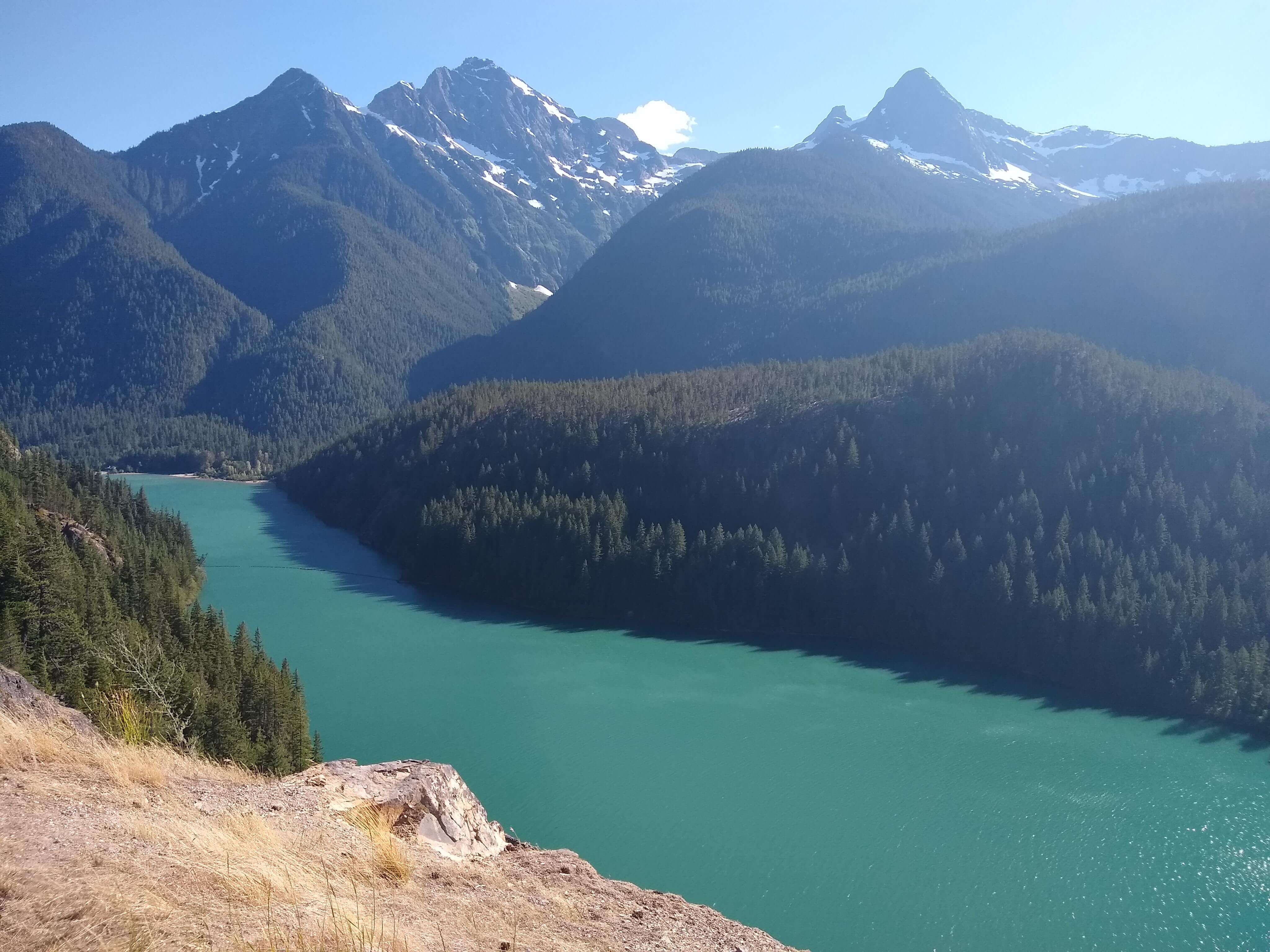
Despite the gorgeous, one-of-a-kind views, North Cascades National Park is one of the ten least visited national parks with roughly 30,000 visitors per year.
Considering that Washington’s other national parks – Olympic National Park and Mount Rainier National Park – each see over a million visitors per year, I’m astounded that more people don’t make the trip up to North Cascades as well.
It’s also surprising how few people visit North Cascades National Park given how easy it is to get there (it’s only two to three hours from Seattle).
Whatever the reason is, North Cascades is definitely one of the most underrated national parks in America.
Ready to get a glimpse of this beautiful park for yourself? Keep reading to learn everything a car camper needs to know before visiting North Cascades National Park.
Click on these links to navigate to a specific section in this guide:
- Planning your trip
- How to get to North Cascades National Park
- Things to do in North Cascades National Park
Planning your trip
When to visit North Cascades National Park
The best time to visit North Cascades National Park is in the summer.
Highway 20 (North Cascades highway), the main highway that runs through North Cascades National Park, closes seasonally due to snow and avalanche risk. Typically, Highway 20 is open from April or May through November.
By planning your trip for the summer, you’ll avoid the risk of Highway 20 being closed, preventing you from traveling through the park.
Click here to check road conditions for Highway 20 and other roads in North Cascades National Park.
Camping in North Cascades National Park
Once you’ve decided when you’d like to visit North Cascades National Park, you’ll want to reserve a campsite.
There are five campgrounds for car camping, ranging in size and type of amenities available. The campgrounds listed in order from largest to smallest are:
- Newhalem Creek Campground
- Colonial Creek South Campground
- Colonial Creek North Campground
- Goodell Creek Campground
- Gorge Lake Campground (note that this is a primitive campground with no water.)
Campsites can be reserved at recreation.gov up to six months in advance.
All of these campgrounds are located along Highway 20.
Can’t find a campsite in North Cascades National Park? Try a service like Campnab which sends you alerts when a reservation is canceled and a campsite becomes available.
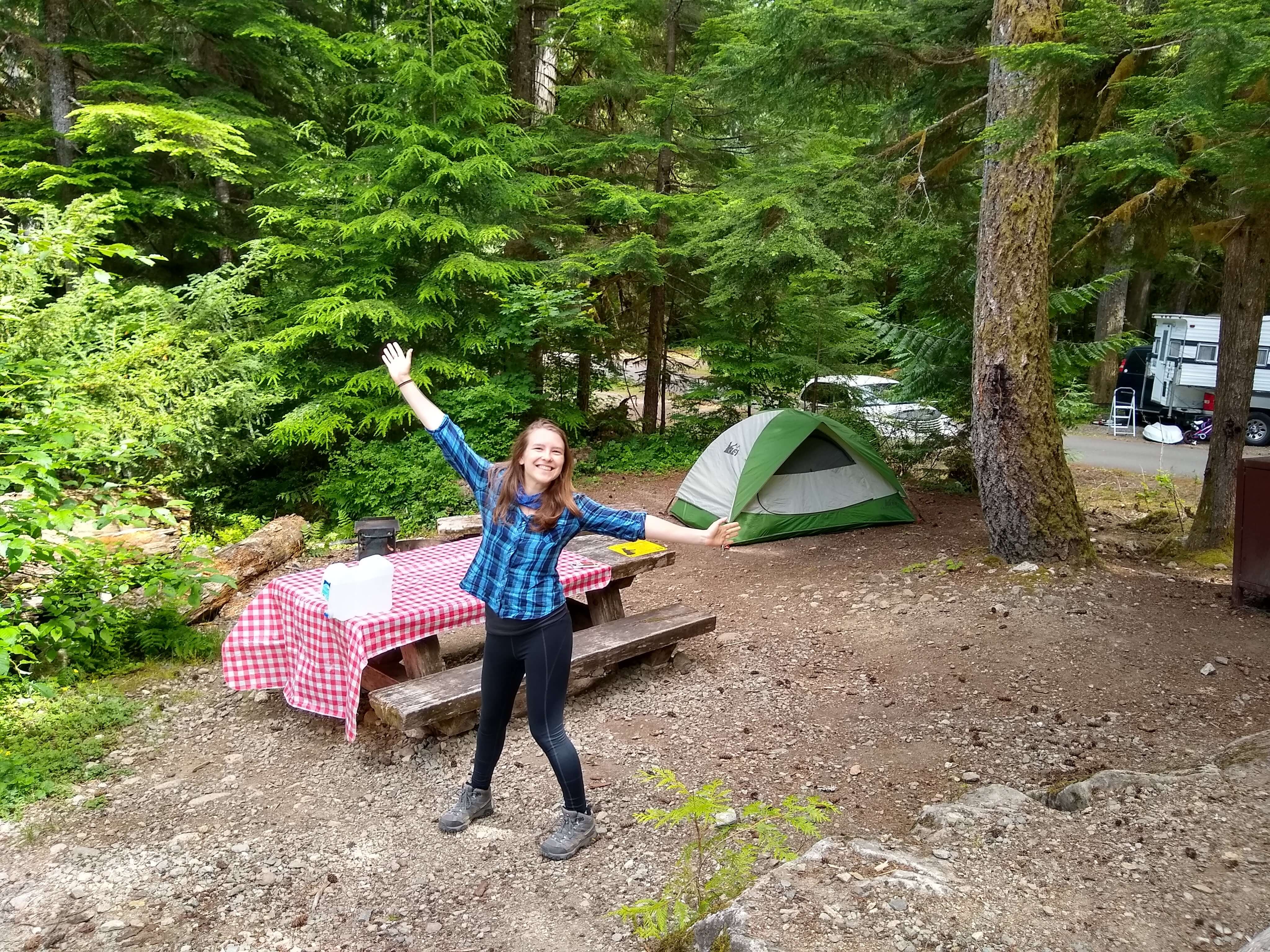
Getting around the park
North Cascades National Park is actually a complex comprised of three sections.
There are two national park areas separated by Ross Lake National Recreation Area. The three lakes in Ross Lake NRA – Ross, Diablo, and Gorge – are actually reservoirs that provide power for the city of Seattle.
The third section of the park is the Lake Chelan National Recreation Area, located at the southeastern end of North Cascades National Park. The Lake Chelan NRA section is not accessible by driving; it can only be accessed by taking a ferry from the southern end of Lake Chelan.
You can see where each of these sections of the complex are on this interactive map of North Cascades National Park.
Most of the easily accessible features of North Cascades National Park are located along Highway 20, which runs east-west through the Ross Lake NRA section of the park.
Cascade River Road connects to Highway 20 and leads visitors further south into the National Park section of the complex to access additional hiking trails.
Note that Cascade River Road is only paved for the first ten miles. After this point, the road is gravel with some potholes.
Cascade River Road is also steep in some sections and there are some sharp turns. We drove on this road in a sedan that we rented, but keep these factors in mind depending on what kind of vehicle you’re driving. The National Park Service does not recommend driving large RVs on this road.
There are no shuttles or other forms of transportation provided by the park. However, the Lodge at Stehekin provides a shuttle service twice daily in the summer through the Lake Chelan Recreation Area.
Other things to know
Unlike most popular national parks, there is no fee to enter North Cascades National Park.
How to get to North Cascades National Park
The nearest major airport to North Cascades National Park is Seattle-Tacoma International Airport (SEA).
From Seattle, North Cascades National Park is about a two and a half hour drive northeast of the city.
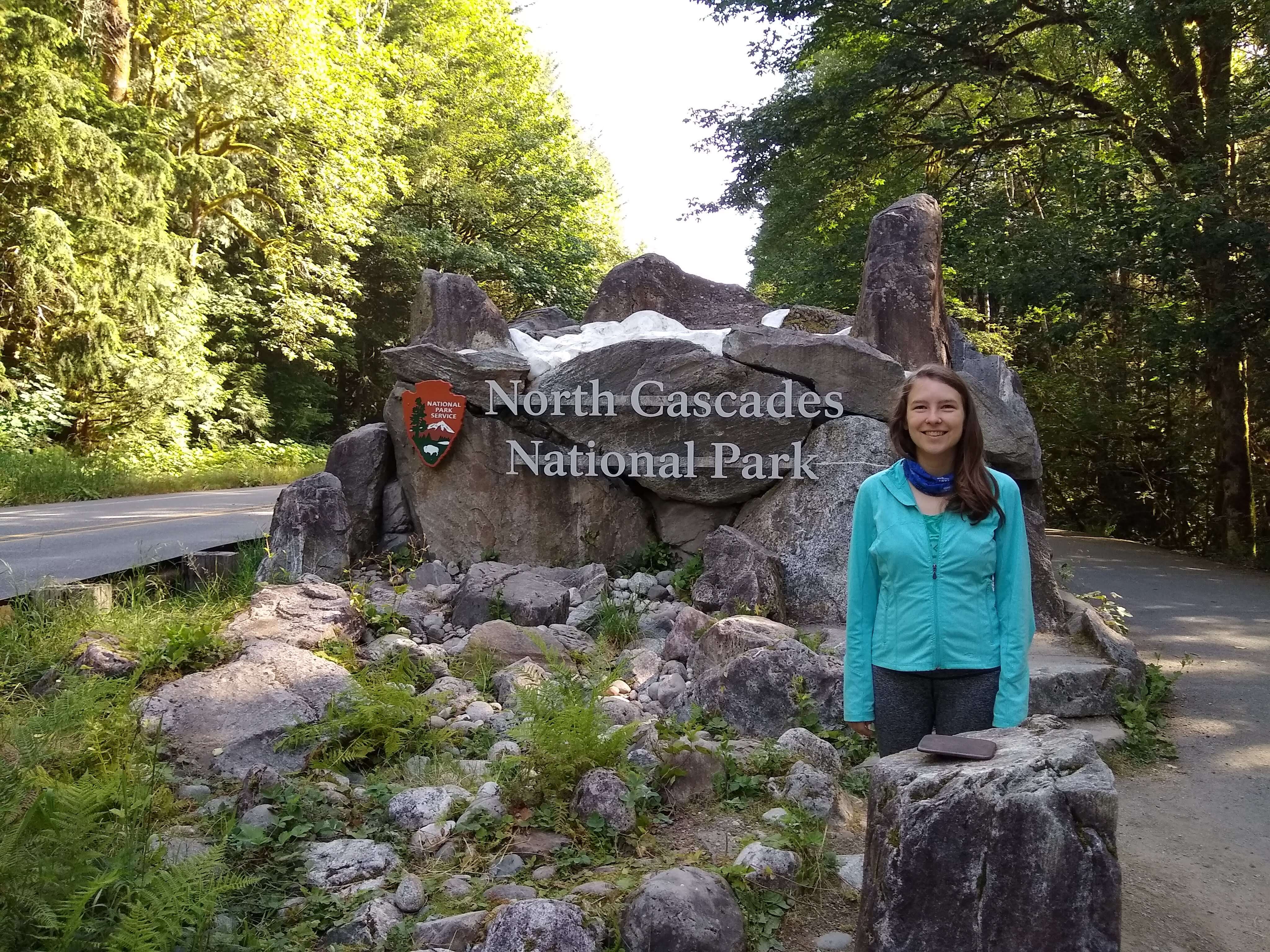
Things to do in North Cascades National Park
Scenic drive along Highway 20
It takes about an hour to drive along the section of Highway 20 that runs through North Cascades National Park. Take a drive along the highway with stops to see these waterfalls and vistas, listed from west to east along the highway:
Ladder Creek Falls
Ladder Creek Falls is located in Newhalem, WA behind the Gorge Powerhouse. The Ladder Falls Trail is a 0.4 mile trail that takes you across the river past the powerhouse and to the falls.
If you check out Ladder Creek falls after dusk, Seattle City Light illuminates the falls in multicolor lights. Perhaps not the natural experience that many visitors seek when visiting a national park, but it’s certainly an experience that is unique to North Cascades National Park.
Gorge Overlook and Gorge Creek Falls
About two miles east of Newhalem is the beginning of Gorge Lake.
Take the half-mile Gorge Overlook Trail to access views of the lake and the Gorge Dam.
Once you’ve walked this loop, cross Highway 20 to access a bridge that leads to the Gorge Creek Falls.
Diablo Lake Overlook
Drive another eight and a half miles (about fifteen minutes) past the Gorge Overlook Trail to reach Diablo Lake Overlook.
Diablo Lake Overlook (labeled Diablo Lake Vista on Google Maps) is the iconic view of North Cascades National Park that you’ll see online. Stop here for jaw-dropping views of the turquoise blue water of Diablo Lake and the surrounding mountains.
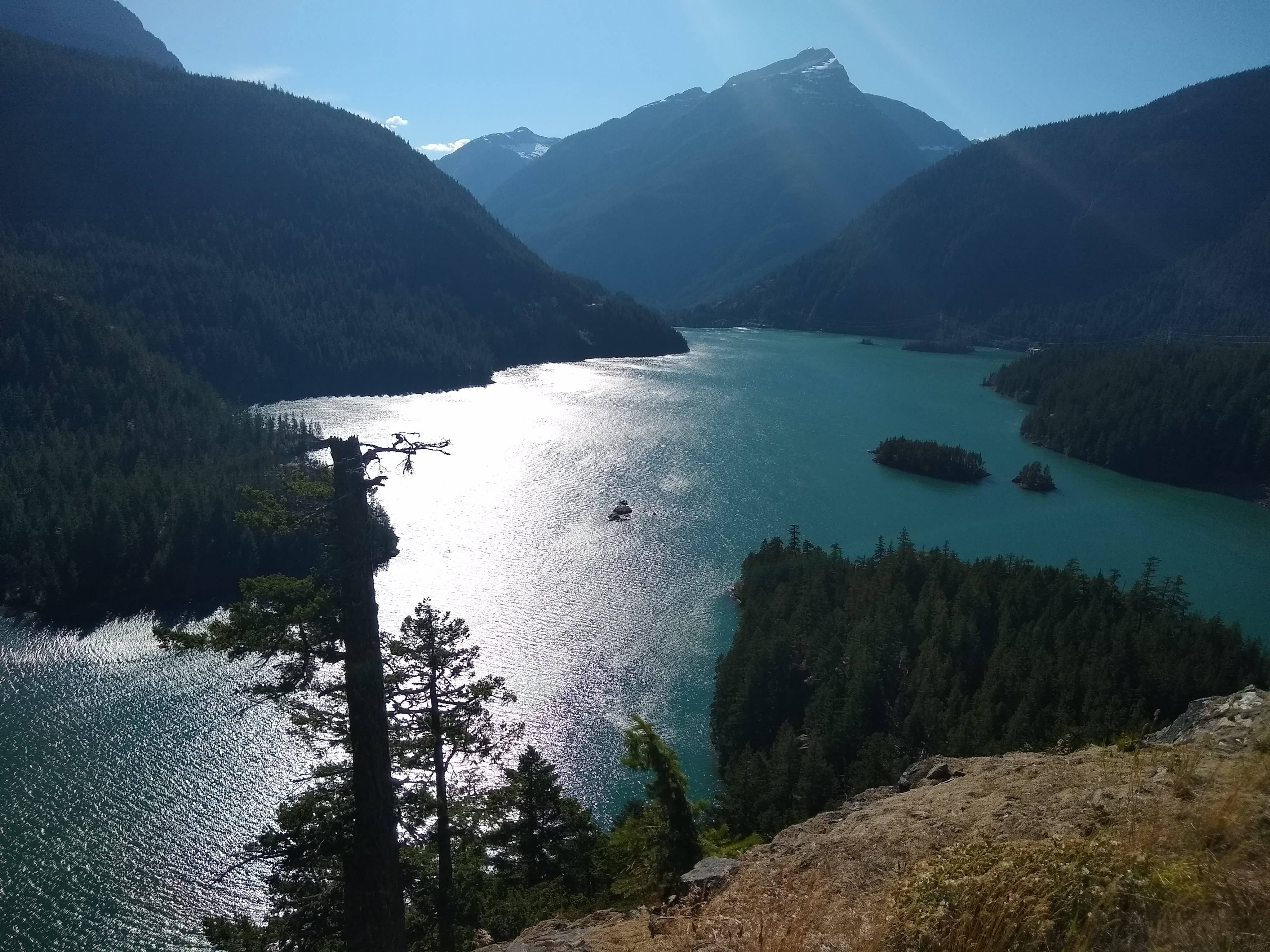
Ross Lake Overlook
Three and a half miles past Diablo Lake Vista is a pullout for Ross Lake Overlook.
The overlook is smaller than that at Diablo Lake and doesn’t have the same amenities, but is still worth stopping to gaze out at Ross Lake and the mountains for a few minutes.
Ross Lake Overlook can be found about three and a half miles (five minutes) past Diablo Lake Vista.
Bonus stop: Washington Pass Observation Site
This stop technically isn’t in North Cascades National Park, but in the neighboring Okanogan-Wenatchee National Forest. However, it’s worth the stop if you want to extend your drive or are driving this far along the highway anyway to access additional hiking trails.
The Washington Pass Observation Site is a quarter-mile path that provides scenic views of Liberty Bell Mountain and surrounding ridges.
Driving from west to east, the road that leads from Highway 20 to the observation site parking lot will be on your left.

Hiking
The National Park Service lists sixteen day hikes in North Cascades National Park ranging from under an hour to a full day.
While any of these trails can offer a good workout, below are a few of the trails in North Cascades with the best viewpoints.
Thunder Knob
- Distance: 3.6 miles roundtrip
- Elevation gain: 425 feet
Thunder Knob is a popular trail in North Cascades National Park, as it’s a relatively easy hike that leads to views of Diablo Lake’s turquoise water.
If you’re heading to this trail and aren’t already camping in Colonial Creek campground, park at the Thunder Knob trailhead along Highway 20 right outside the entrance to the campground.

Cascade Pass
- Distance: 7 miles roundtrip
- Elevation gain: 1800 feet
Cascade Pass offers picturesque views of a valley carved by glaciers.
Along the way, lucky hikers may see adorable pikas and marmots.
The Cascade Pass trailhead itself has beautiful views on its own, if you’re not up for the seven mile hike.
The trailhead is located at the very end of Cascade River Road (see description of CRR in the Getting Around section above). Though despite the large parking lot, you may have to park along the Cascade River Road as the parking lot fills up quickly.

Hidden Lake
- Distance: 8 miles roundtrip
- Elevation gain: 3300 feet
Some argue that Hidden Lake is one of the best hikes in the state of Washington.
The trail takes you through forest, open meadows with wildflowers, and all the way up to not just Hidden Lake but 360 degree views of surrounding peaks.
You won’t get to these views easily though; the trail is moderately strenuous and often still has snow well into summer.
To get to the trailhead, turn off Cascade River Road at the dirt road that points to Hidden Lake Trail.
This dirt road, which is steep in sections and is filled with huge potholes, runs for four miles before reaching the Hidden Lake trailhead. We did not feel comfortable taking our rental car up this road, but we were later told that the first mile of road is the worst part and that even a Prius was spotted at the trailhead earlier that day.
Bonus hike: Blue Lake
- Distance: 4.4 miles roundtrip
- Elevation gain: 1050 feet
If you’re looking for another easier day hike that doesn’t require driving on steep dirt roads to access but still has a good view, I would recommend heading just outside the park to Blue Lake trail.
The trail winds through forests and meadows with wildflowers up to the aptly named mountain lake that seems to appear out of nowhere.
Blue Lake trailhead is located right off of Highway 20 in the Okanogan-Wenatchee National Forest just under a mile away from the Washington Pass Observation Site. Since this hike is located outside the national park, you will either need to bring a Northwest Forest Pass or pay $5 in cash when you arrive at the trailhead.
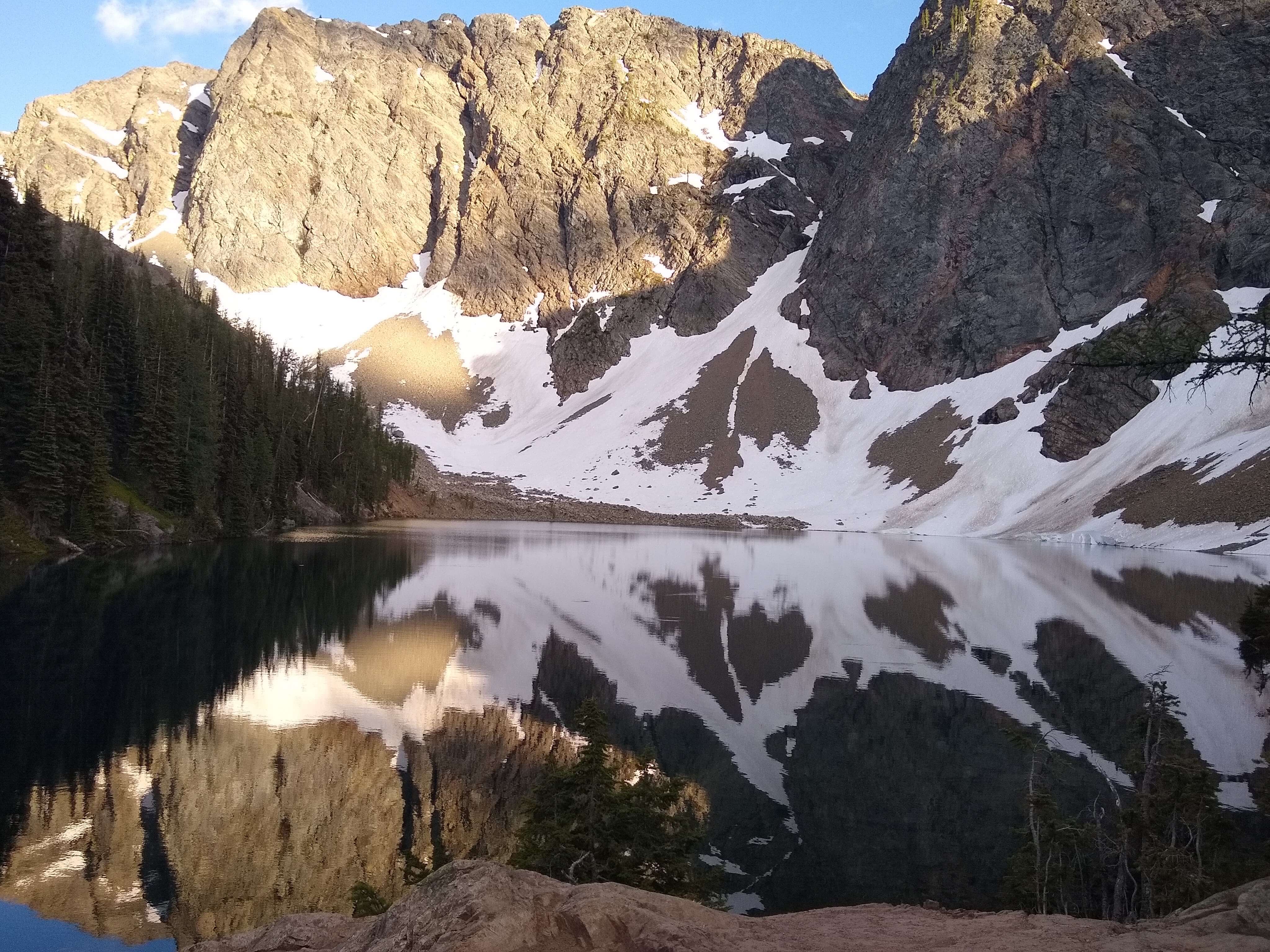
Boating
There are no boat rentals at Gorge or Diablo lakes, but both lakes have boat ramps if you have your own boat.
At Ross Lake, the Ross Lake Resort rents motorboats, kayaks, canoes, and stand up paddleboards (SUPs) which must be reserved in advance on their website. Note that getting to Ross Lake Resort requires hiking 3.5 miles each way, though part of the hike can be replaced with a shuttle service operated by the resort.
Keep in mind that personal watercraft like jet skis as well as activities that require being towed behind a boat (waterskiing and tubing) are not allowed within the North Cascades National Park Service Complex.
Need more help planning your trip? Check out my seven tips to plan a perfect national park trip!
As always, enjoy the outdoors responsibly. Leave no trace on all of your adventures.
